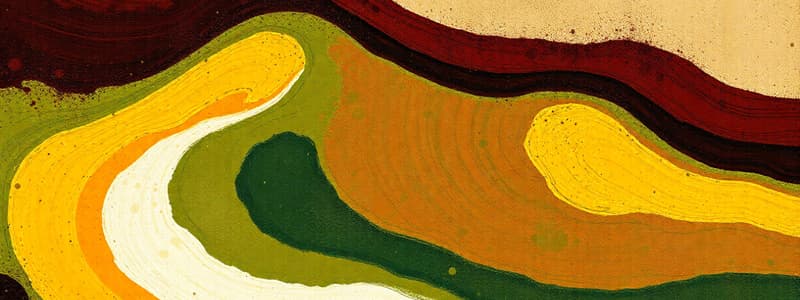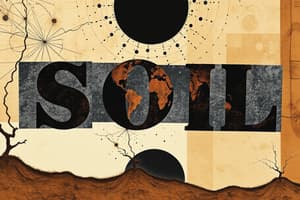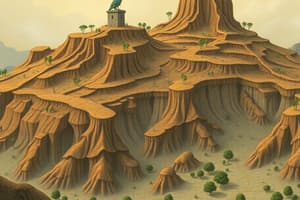Podcast
Questions and Answers
What is the primary source of minerals found in soil?
What is the primary source of minerals found in soil?
- Water held within soil pores
- Weathered rocks (correct)
- Air spaces within the soil
- Decomposed plants and animals
Which of the following is NOT a component of the pedosphere?
Which of the following is NOT a component of the pedosphere?
- Stratosphere (correct)
- Hydrosphere
- Biosphere
- Lithosphere
What is the significance of organic matter in soil?
What is the significance of organic matter in soil?
- It helps to bind soil particles together, improving soil structure.
- It provides a source of energy for plants.
- It enhances soil fertility and water retention. (correct)
- It increases soil aeration and drainage.
Which of the following is the most accurate description of the pedosphere?
Which of the following is the most accurate description of the pedosphere?
Why is the pedosphere considered the "living skin" of the Earth?
Why is the pedosphere considered the "living skin" of the Earth?
What is the role of air spaces (pores) in soil?
What is the role of air spaces (pores) in soil?
Which of the following is NOT an example of a diastrophic movement?
Which of the following is NOT an example of a diastrophic movement?
Which of the following is NOT a factor that contributes to the formation of soil?
Which of the following is NOT a factor that contributes to the formation of soil?
What is the primary function of water in soil?
What is the primary function of water in soil?
What is the primary purpose of grassed waterways in agricultural landscapes?
What is the primary purpose of grassed waterways in agricultural landscapes?
What is the main characteristic that distinguishes epeirogenic movements from orogenic movements?
What is the main characteristic that distinguishes epeirogenic movements from orogenic movements?
Which of the following describes the process of tension in the context of orogenic movements?
Which of the following describes the process of tension in the context of orogenic movements?
What is a key benefit of agroforestry practices for agricultural landscapes?
What is a key benefit of agroforestry practices for agricultural landscapes?
Which type of diastrophic movement involves the lifting of the Earth's surface?
Which type of diastrophic movement involves the lifting of the Earth's surface?
What is the primary difference between endogenic and exogenic movements?
What is the primary difference between endogenic and exogenic movements?
Which of the following is NOT a direct result of orogenic movements?
Which of the following is NOT a direct result of orogenic movements?
What is the purpose of layers of sediment in ancient oceans?
What is the purpose of layers of sediment in ancient oceans?
On the Mohs Hardness Scale, which mineral is the hardest?
On the Mohs Hardness Scale, which mineral is the hardest?
What type of rock formation is characterized by compacted and solidified dissolved minerals?
What type of rock formation is characterized by compacted and solidified dissolved minerals?
Which of the following is NOT a key physical property used to identify minerals?
Which of the following is NOT a key physical property used to identify minerals?
Which of these is NOT a key factor in the metamorphism of rocks?
Which of these is NOT a key factor in the metamorphism of rocks?
How is the hardness of a mineral determined on the Mohs Hardness Scale?
How is the hardness of a mineral determined on the Mohs Hardness Scale?
Which of the following statements about the Mohs Hardness Scale is TRUE?
Which of the following statements about the Mohs Hardness Scale is TRUE?
Which type of rock is formed from compacted broken rocks?
Which type of rock is formed from compacted broken rocks?
Which of these examples best represents an organic sedimentary rock?
Which of these examples best represents an organic sedimentary rock?
What is the most abundant mineral in the Philippines, according to the content provided?
What is the most abundant mineral in the Philippines, according to the content provided?
What is the primary factor that influences the shape of a mineral?
What is the primary factor that influences the shape of a mineral?
What is the process that transforms existing rocks into metamorphic rocks?
What is the process that transforms existing rocks into metamorphic rocks?
Which of the following is a common environment where metamorphic rocks form?
Which of the following is a common environment where metamorphic rocks form?
Which of the following properties refers to how a mineral reflects light?
Which of the following properties refers to how a mineral reflects light?
What type of rock is formed from compacted, rounded gravel and pebbles?
What type of rock is formed from compacted, rounded gravel and pebbles?
What role does pressure play in the formation of metamorphic rocks?
What role does pressure play in the formation of metamorphic rocks?
Why is copper considered vital to the Philippine economy?
Why is copper considered vital to the Philippine economy?
What is the primary use of nickel?
What is the primary use of nickel?
What is a common characteristic of early human tools and utensils?
What is a common characteristic of early human tools and utensils?
What was a significant advancement in ancient civilizations related to stone?
What was a significant advancement in ancient civilizations related to stone?
What is the primary objective of mining?
What is the primary objective of mining?
Which type of mining is suitable for extracting resources found in horizontal layers near the surface?
Which type of mining is suitable for extracting resources found in horizontal layers near the surface?
Which of the following is NOT a common type of mining?
Which of the following is NOT a common type of mining?
Which of the following is NOT a use of rocks and minerals mentioned in the text?
Which of the following is NOT a use of rocks and minerals mentioned in the text?
Which mining method is particularly effective for extracting minerals located near the surface but deeper than what can be accessed by strip mining?
Which mining method is particularly effective for extracting minerals located near the surface but deeper than what can be accessed by strip mining?
What type of mining is commonly used for extracting gold located beneath the surface?
What type of mining is commonly used for extracting gold located beneath the surface?
The Philippines is known for its abundance of which three key minerals?
The Philippines is known for its abundance of which three key minerals?
What term describes the rock containing valuable minerals that can be mined and processed for profit?
What term describes the rock containing valuable minerals that can be mined and processed for profit?
What factor determines the metal content of an ore?
What factor determines the metal content of an ore?
Which mining method is commonly used in hilly areas?
Which mining method is commonly used in hilly areas?
What is the mineral name of salt?
What is the mineral name of salt?
Which mining method accounts for about 70% of the coal extracted?
Which mining method accounts for about 70% of the coal extracted?
Flashcards
Pedosphere
Pedosphere
The thin outer layer of Earth, interface of lithosphere, atmosphere, hydrosphere, and biosphere.
Lithosphere
Lithosphere
The solid outer part of the Earth, including the crust and upper mantle.
Atmosphere
Atmosphere
The layer of gases surrounding Earth, essential for life.
Hydrosphere
Hydrosphere
Signup and view all the flashcards
Biosphere
Biosphere
Signup and view all the flashcards
Soil
Soil
Signup and view all the flashcards
Organic Matter
Organic Matter
Signup and view all the flashcards
Soil Pores
Soil Pores
Signup and view all the flashcards
Agroforestry
Agroforestry
Signup and view all the flashcards
Grassed Waterways
Grassed Waterways
Signup and view all the flashcards
Endogenic Movements
Endogenic Movements
Signup and view all the flashcards
Diastrophic Movements
Diastrophic Movements
Signup and view all the flashcards
Catastrophism
Catastrophism
Signup and view all the flashcards
Epeirogenic Movements
Epeirogenic Movements
Signup and view all the flashcards
Orogenic Movements
Orogenic Movements
Signup and view all the flashcards
Tension and Compression
Tension and Compression
Signup and view all the flashcards
Compaction
Compaction
Signup and view all the flashcards
Cementation
Cementation
Signup and view all the flashcards
Conglomerate
Conglomerate
Signup and view all the flashcards
Sandstone
Sandstone
Signup and view all the flashcards
Siltstone
Siltstone
Signup and view all the flashcards
Metamorphism
Metamorphism
Signup and view all the flashcards
Key Factors in Metamorphism
Key Factors in Metamorphism
Signup and view all the flashcards
Subduction Zones
Subduction Zones
Signup and view all the flashcards
Marine Sediments
Marine Sediments
Signup and view all the flashcards
Mohs Hardness Scale
Mohs Hardness Scale
Signup and view all the flashcards
Hardness
Hardness
Signup and view all the flashcards
Mineral Luster
Mineral Luster
Signup and view all the flashcards
Mineral Color
Mineral Color
Signup and view all the flashcards
Mineral Shape
Mineral Shape
Signup and view all the flashcards
Top Minerals PH
Top Minerals PH
Signup and view all the flashcards
Physical Properties of Minerals
Physical Properties of Minerals
Signup and view all the flashcards
Strip Mining
Strip Mining
Signup and view all the flashcards
Area Strip Mining
Area Strip Mining
Signup and view all the flashcards
Contour Strip Mining
Contour Strip Mining
Signup and view all the flashcards
Open-Pit Mining
Open-Pit Mining
Signup and view all the flashcards
Underground Mining
Underground Mining
Signup and view all the flashcards
Mining Salt
Mining Salt
Signup and view all the flashcards
Ore
Ore
Signup and view all the flashcards
Philippines Mining
Philippines Mining
Signup and view all the flashcards
Copper Reserves
Copper Reserves
Signup and view all the flashcards
Nickel Reserves
Nickel Reserves
Signup and view all the flashcards
Mining
Mining
Signup and view all the flashcards
Uses for Rocks
Uses for Rocks
Signup and view all the flashcards
Stone Tools
Stone Tools
Signup and view all the flashcards
Study Notes
The Pedosphere
- The pedosphere is the outermost layer of Earth, acting as an interface between the lithosphere, atmosphere, hydrosphere, and biosphere.
- It's crucial for life's sustenance.
- It's the "living skin" of the Earth.
What is Soil?
- Soil is a complex, dynamic system composed of:
- Minerals: Inorganic materials from weathered rocks, supplying nutrients to plants.
- Organic Matter: Decomposed plants and animals, enhancing soil fertility and structure.
- Gases: Air spaces (pores) allowing oxygen to reach plant roots.
- Liquids: Water held within soil pores, dissolving nutrients for plant use.
- Organisms: Diverse communities (bacteria, fungi, earthworms), contributing to soil health by decomposing, cycling nutrients, and building soil structure.
Factors Affecting Soil Formation
- Parent Material: Underlying geological material (bedrock or sediment) influencing soil mineral composition.
- Climate: Temperature and precipitation affecting weathering rates and organic matter decomposition. Warm, moist climates speed up soil formation.
- Topography: Slope and elevation influencing water drainage and erosion rates. Steeper slopes lead to thinner soils.
- Biological Factors: Presence of plants, animals, and microorganisms contributing to soil formation through root penetration, organic matter decomposition, and nutrient cycling.
- Time: Soil formation is a slow process, leading to more developed soils over longer periods, with distinct layers (horizons) and higher nutrient content.
Soil Production
- Soil production is the conversion of solid rock into soil through weathering (physical and chemical) and biological activity.
- Weathering breaks down rocks into smaller particles.
- Biological activity (plant roots, microbes) adds organic matter.
- Soil thickness depends on the balance between soil production and transport downslope.
Soil Triangle
- A diagram used to classify soil types based on the relative percentages of sand, silt, and clay.
- Sand: Large particles, good drainage, low water retention.
- Silt: Medium-sized particles, moderate water retention and nutrient holding capacity.
- Clay: Smallest particles, high water retention and nutrient holding capacity.
Soil Horizons
- Soil is organized into horizontal layers called soil horizons, differing in composition, texture, and color.
- O Horizon (Organic Layer): Mostly organic matter (decomposed leaves, plants, animals).
- A Horizon (Topsoil): Minerals mixed with organic material (humus), major root activity zone.
- E Horizon (Eluviation Layer): Zone of leaching, minerals and nutrients washed out, lighter color.
- B Horizon (Subsoil): Minerals and metal salts leached from upper layers, often denser.
- C Horizon (Parent Rock): Partly weathered rock, the source material for the soil.
- R Horizon (Bedrock): Unweathered rock, the base of the soil profile.
Soil Conservation Practices
- Contour Farming: Plowing along contours of the land to minimize water runoff and soil erosion.
- Strip Cropping: Alternating different crops across slopes reduces erosion and retains soil moisture.
- Crop Rotation: Planting different crops sequentially to improve soil health, enhance nutrient balance, and reduce erosion.
- Cover Cropping: Growing cover crops (legumes, grasses) to protect soil from erosion, improve soil fertility, and increase moisture retention.
- Agroforestry: Integrating trees and shrubs into agricultural landscapes protects soil, improves biodiversity, and reduces erosion.
- Grassed Waterways: Creating grass-covered channels to guide surface runoff, preventing soil erosion and maintaining water quality.
Endogenic and Exogenic Movements
- Endogenic Movements (Internal Forces):
- Diastrophic Movements (Slow): Gradual deformation of Earth's crust (e.g., mountain formation).
- Catastrophism (Sudden): Rapid events causing immediate changes to Earth's crust (e.g., earthquakes, volcanic eruptions).
- Epeirogenic (Continent Forming): Upward or downward movement of the Earth's surface, leading to changes in elevation over large areas.
- Orogenic (Mountain Building): Formation of mountain ranges through tectonic forces.
- Exogenic Movements (External Forces):
- Weathering: Breakdown of rocks by physical (e.g., frost wedging, exfoliation) and chemical (e.g., oxidation, hydration) processes, including biological processes.
- Erosion: Movement of sediment from broken rock by forces like water, wind, ice, gravity.
- Deposition: Dropping of sediment in a new location, shaping landscapes over time.
Tectonic Plate Boundaries
- Divergent Boundaries: Plates move apart, creating new oceanic lithosphere (e.g., Mid-Atlantic Ridge).
- Convergent Boundaries: Plates move toward each other, with one plate often subducting beneath the other, creating deep ocean trenches and volcanic arcs (e.g., Andes mountains).
- Transform Boundaries: Plates slide past each other, causing no significant topographic changes (e.g., San Andreas Fault).
Mountain Formation
- Fold Mountains: Formed when two tectonic plates collide, causing layers of rocks and sediments to buckle and fold.
- Rift Valleys: Formed at divergent boundaries where tectonic plates move apart, causing magma from the mantle to rise, creating a rift, thinning the crust, and leading to a valley formation.
Subduction and the Formation of the Philippines
- Subduction is the process of one tectonic plate moving beneath another.
- The Philippines exists because of subduction between the Philippine and Eurasian plates, with the Philippine plate subducting beneath Eurasia.
The Rock Cycle
- Explains the processes by which rocks transform from one type (igneous, metamorphic, sedimentary) to another.
- These transformations are driven by internal (heat, pressure) and external (water, wind, gravity) forces.
- Heat, pressure, weathering, and lithification drive the rock cycle.
Types of Rocks
- Igneous Rocks: Formed from the cooling and solidification of molten rock (magma or lava).
- Extrusive: Cools quickly on Earth's surface, resulting in fine-grained or glassy textures.
- Intrusive: Cools slowly beneath Earth's surface, allowing larger crystals to form.
- Sedimentary Rocks: Formed from the accumulation of eroded particles of minerals, rocks, and fossils.
- Clastic: Formed from cemented pieces of other rocks.
- Chemical: Formed from dissolved minerals precipitated from water.
- Organic: Formed from compacted plant or animal remains.
- Metamorphic Rocks: Formed when existing rocks undergo changes due to extreme heat and pressure deep within the Earth, altering their mineral composition, texture, and structure.
Minerals vs. Rocks
- Minerals: Naturally occurring, inorganic solids with a definite chemical composition and ordered internal structure (crystalline).
- Rocks: Solid aggregates of one or more minerals or mineraloids, lacking a specific and definite chemical composition.
Mineral Physical Properties
- Identify minerals through key properties, including:
- Hardness: Resistance to scratching (Mohs Hardness Scale).
- Shape: External shape reflecting internal crystal structure.
- Luster: How a mineral reflects light (metallic, dull).
- Color: Outward appearance, often affected by impurities.
Top 6 Minerals in the Philippines
- Gold: Abundant mineral, important for the economy of the Philippines.
- Copper: Crucial for electronics and construction.
- Nickel: Essential for stainless steel and industrial products.
- Other minerals also listed (like chromite, iron, and aluminum) that are significant in the Philippines, often used by local communities for utensils and tools.
Mining
- Extraction of valuable resources (metals, minerals, etc.) from the Earth's crust.
- Strip Mining: Extracting minerals from horizontal beds close to the surface..
- Open-Pit Mining: Digging large holes to extract materials.
- Underground Mining: Create tunnels to access materials deep beneath the surface.
Responsible Mining
- Considers environmental impact and local communities.
Fossil Fuels
- Still used due to established infrastructure, high energy density, and reliability in comparison to alternative energy sources.
Steno's Laws of Stratigraphy
- Explain the patterns in which rock layers are deposited.
- Law of Superposition: Younger layers are above older layers in undisturbed sequences.
- Law of Original Horizontality: Layers of sediment are generally deposited horizontally.
- Law of Cross-Cutting Relationships: A feature cutting across another is younger than the feature it cuts across.
- Law of Lateral Continuity: Layers of rock are originally continuous until encountering barriers.
Fossils
- Preserved remains or imprints of organisms from past life periods.
- Principle of Faunal Succession: Organisms evolve over time, creating a sequence in preserved remains (fossils) in rock layers, allowing age dating.
- Types:
- Trace Fossils: Imprints of organism's activities.
- Mold Fossils: Impressions of organisms.
- Body Fossils: Actual remains (bones, shells).
Studying That Suits You
Use AI to generate personalized quizzes and flashcards to suit your learning preferences.




